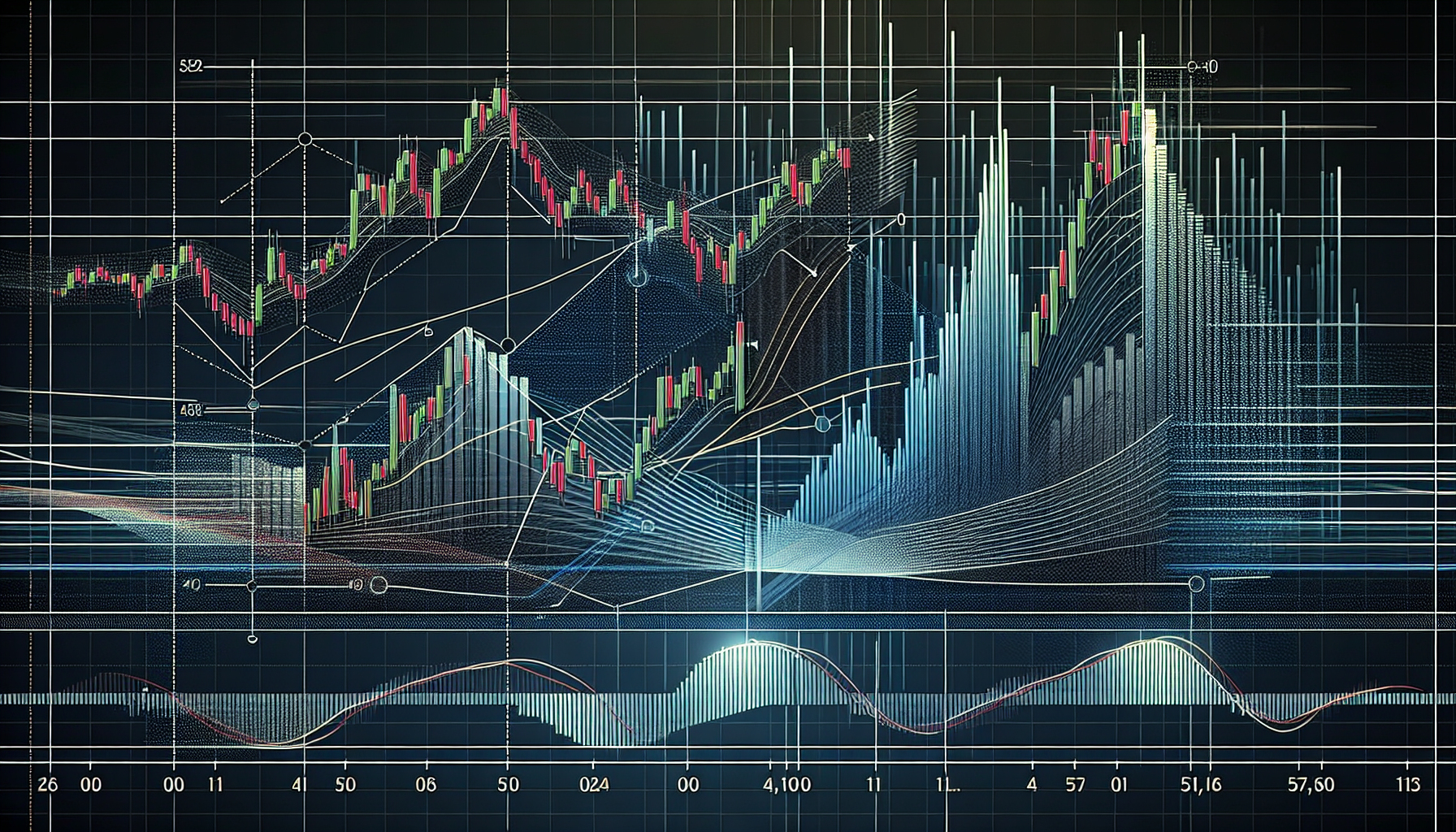When trading in dynamic markets, effectively gauging when to buy and sell is crucial. Fibonacci retracement with stochastic and macd confirmation, can significantly enhance this timing. This article zeroes in on how to leverage these technical indicators together for robust trade analysis, offering you the insights you need to refine your trading strategy without the fluff.
Key Takeaways
- Fibonacci retracement is a critical tool for traders to identify potential support and resistance levels by using key ratios such as 23.6%, 38.2%, 50%, and 61.8% based on the Fibonacci sequence.
- The stochastic oscillator is used alongside Fibonacci retracement to gauge market momentum and pinpoint trend reversals, with under 20 indicating oversold and over 80 signaling overbought conditions.
- MACD provides additional trade entry and exit confirmation when combined with Fibonacci retracement and stochastic readings, reducing the risk of false signals and enhancing trading strategy efficacy.
Unlocking the Power of Fibonacci Retracement in Trading

One of the key tools in a trader’s arsenal is the Fibonacci retracement, which is part of the effective fibonacci trading tools. It’s a simple yet powerful tool that helps traders identify critical support and resistance levels based on the Fibonacci sequence. This tool is embraced for its simplicity and effectiveness.
Drawing and testing
It requires only two data points – the high and low price levels. The tool’s reliability improves when used over longer periods, as it aggregates more data.
Understanding Key Fibonacci Ratios
Unraveling the world of Fibonacci retracements begins with understanding its key ratios. The series of Fibonacci retracement ratios consists of:
- 0.25
- 0.38
- 0.50
- 0.618
- 0.786
- 0.886
- 0.00 and 1.00 (the extremities)
These ratios are commonly used in technical analysis for identifying potential levels of support and resistance in financial markets. Among these, the 0.618 ratio, representing the inverse of the golden ratio, holds particular significance in Fibonacci trading due to its ubiquitous presence in nature and financial markets.
Integrating Stochastic Oscillator for Enhanced Signals

By measuring momentum and confirming potential support and resistance levels indicated by Fibonacci levels, the stochastic oscillator provides an extra dimension to trading. This oscillator can be used alongside the Fibonacci retracement to identify potential reversal points in the market.
When the price retraces to a Fibonacci level and the stochastic oscillator signals an overbought or oversold condition, it can be a strong indication of a potential trend reversal.
Interpreting Stochastic Readings
The oscillator consists of two lines: the %K line, which indicates the actual value of the oscillator, and the %D line, which is a three-day simple moving average of %K.
Stochastic readings above 80 typically signal that the stock is overbought, whereas readings below 20 indicate that the stock is oversold.
Timing Entries with Stochastic Crossovers
A crossover in the stochastic oscillator occurs when the %K line intersects with the %D line, signaling potential price momentum reversals. Traders utilize crossovers of the %K and %D lines in the stochastic oscillator as entry or exit signals, with a crossover above the %D line in oversold territory signaling a buy, and a crossover below the %D line in overbought territory signaling a sell.
Applying MACD for Confirmation

The MACD indicator serves to add an extra layer of precision to your trading strategy. This tool can provide additional confirmation of trend reversals at Fibonacci levels, thus strengthening trade setups. The MACD is made up of two lines – the MACD line and the signal line.
The convergence and divergence of these lines signal potential bullish or bearish momentum.
The MACD Histogram and Signal Line
By charting the distance between the MACD line and the signal line, the MACD histogram visually represents momentum, reflecting the difference between these two lines.
When the MACD line crosses above the signal line, it suggests a bullish trend reversal, hence a buy signal, whereas a cross below indicates a bearish trend reversal and a sell signal.
Combining MACD with Fibonacci and Stochastic
For a more effective trading strategy, one can combine MACD with stochastic oscillator readings and Fibonacci levels to identify opportune moments for trades, effectively reducing the risk of false signals.
The presence of bullish or bearish crossovers in the MACD, when a Fibonacci level corresponds with a stochastic signal, can validate and improve the reliability of trade entry and exit points.
Risk Management Techniques
Any trading strategy inherently includes risk management as an integral part. Techniques such as stop-loss orders and position sizing are essential to protect against sudden market reversals. Fibonacci retracement levels can serve as strategic points for setting stop-loss orders, with traders often placing them just below Fibonacci levels when in long positions to minimize potential losses.
Real-World Examples: Fibonacci with Stochastic and MACD
To contextualize these concepts, we’ll examine some real-world examples of trading strategies that utilize Fibonacci retracement, stochastic oscillator, and MACD indicators. These examples will help to illustrate how these tools can be used in concert to enhance trading outcomes.
Bullish Trend Reversal Example
Consider a bullish trend reversal scenario. In such cases, a bullish signal line crossover in the MACD is a confirmation of a trend reversal at support levels. When this crossover is coupled with a rise in the Stochastic above 20, it indicates a buying opportunity signaling the reversal from a downtrend to an uptrend.
Bearish Trend Continuation Example
In a bearish trend continuation scenario, the reversal at the 61.8% retracement level is a key indicator that can help traders decide on entering short positions. The MACD provides additional confirmation which fortifies traders’ decision to enter their positions during the indicated bearish trend continuation.
Using Extensions and Projections
Your trading strategy can gain an extra layer of sophistication with the addition of Fibonacci extensions and projections, such as the Fibonacci trading strategy. These tools can be used for setting profit targets and estimating future support and resistance levels. Fibonacci extensions include hyper-extended levels such as 161.8%, 261.8%, and 423.6% beyond the standard 100% retracement level. These extensions serve as excellent tools for setting profit targets, giving traders predefined levels to take profits in line with the prevailing trend.
Conclusion
Fibonacci retracements, stochastic oscillators, and MACD are powerful tools that can greatly enhance your trading strategy. By understanding these tools and their interplay, you can identify key support and resistance levels, time trade entries, and confirm trend reversals with greater precision. This comprehensive approach, backed by real-world examples and advanced tips, equips you with a robust trading strategy that can help navigate the complex world of trading with greater confidence and precision.
Frequently Asked Questions
How do you use Fibonacci retracement with MACD?
You can use Fibonacci retracement with MACD by looking for a crossing over of the MACD indicator when a security’s price touches an important Fibonacci level and then opening a position in the direction of the trend.
Which indicator works best with Fibonacci retracement?
The MACD indicator works best with Fibonacci retracement to identify potential trend reversals. Try using MACD with Fibonacci retracement for effective analysis.
How do you confirm Fibonacci retracement?
To confirm Fibonacci retracement, you would look two MACD and Stochastic signals on a stock’s chart. This can help identify overbought This can help identify overbought or oversold situations and stock momentum..
What is the best time frame to use Fibonacci retracement?
The best time frame to use Fibonacci retracement is a 30- to 60-minute candlestick chart, which allows you to focus on the daily market swings at regular intervals. This time frame helps in identifying the most popular retracement levels such as 22.6%, 38.2%, 50%, 61.8%, and 78.6%.
What is the significance of the Fibonacci retracement in trading?
The Fibonacci retracement is significant in trading as it helps identify key support and resistance levels based on the Fibonacci sequence, making it a powerful and appreciated tool in the trading world.


